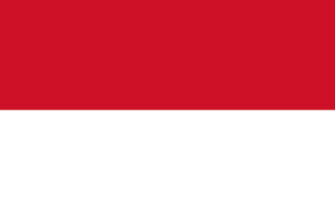The Republic of Slovenia (Slovenia) is a southern European state with a population of 2.1 million people and a territory of 20,200 square kilometers. It is one of the newly created states, resulting from the dissolution of Yugoslavia in the late 20th century.
This is what the modern flag of Slovenia looks like:

History of the flag
The territory of present-day Slovenia began to be settled by Slavs in the sixth and eighth centuries AD. Gradually small states were founded here, merging into larger ones. In the 14th century the region came under the rule of the Habsburgs, and later became part of the Austro-Hungarian Empire.

At the beginning of the 19th century and especially during the revolutionary events of 1848-1849 the Slovenian national movement was born and began to rise. The white-blue-red cloth as a symbol of the Krajina region (a large part of present-day Slovenia) was first raised in April 1848 in Ljubljana, on Presherna Square. Despite the opposition of the Germans, the Austrian government officially recognized it as a national symbol and the flag quickly enough became the only all-Slovenian symbol, regardless of where they lived.

In 1918. Slovenia became part of the Kingdom of Serbs, Croats and Slovenes (after 1929 the Kingdom of Yugoslavia).

In 1941 its territory was occupied by Italy and Germany. Slovenians took an active part in the resistance. Symbols of that period were:
- partisan banner;

- militia sign;

- the banner of the Slovenian militia.

With the end of the war and the creation of the Federal Yugoslavia in 1945, Slovenia was included in the status of a socialist republic. At that time a new kind of symbolism was developed — a five-pointed red star with a yellow border was represented in the center of the three-color cloth.

In December 1990 the independence of the Republic of Slovenia was proclaimed and the country became a separate state after the collapse of Yugoslavia. The red star was removed from the flag and instead the coat of arms was presented on the symbol. In June of the following year, the new form of the flag was adopted.
Description
The flag of the Republic is a rectangular cloth, the sides of which relate to each other as 1 to 2. The symbol of the country is represented by three horizontal equal stripes:
- The white one is on top;
- The blue one is in the middle;
- The red one is from the bottom.
The upper wing of the flag (closer to the staff) shows the country’s coat of arms, which is a shield with a narrow border of red. The overall background of the shield is azure.

Closer to the base of the shield, two wavy lines are drawn, dividing the overall white figure into two parts. The upper one symbolizes Mount Triglav. The wavy lines represent the Adriatic Sea and other water resources (rivers) of the country. In the upper part of the shield, above the mountain, there are three six-pointed stars of golden color, arranged in a triangle, similar to the coat of arms of Counts Celsius.

The image of the Triglav and wavy lines was also on the coat of arms of the Socialist Republic of Slovenia within Yugoslavia. In contrast to the modern emblem of the Republic, its frame is made with ears of wheat and linden leaves, tied with a red ribbon.

Flag colors
The main colors used on the flag of the Republic are: white, blue and red. In addition to these, yellow is used to represent the stars.
Meaning of colors and flag symbol
Slovenia’s tricolor cloth is among the flags of Slavic countries that use traditional pan-Slavic colors, which have the following designation:
- white — nobility,
- blue — freedom,
- red — spilled blood.
The stars on the coat of arms are a symbol of Slovenian independence, acquired in the 15th century by the Slovenian Duchy of Celje (Celje).
In addition to this interpretation of the stars, another is used to symbolize three fateful dates in the history of Slovenia:
- the country’s liberation from Austro-Hungarian rule in 1918,
- liberation from German and Italian occupation in 1945,
- the declaration of independence of the state in 1991.
Other Flags
Symbols of government affiliation, as well as other state structures and institutions are approved and used in the republic. These are flags:
- Президента страны;

- Chairman of the National Assembly;

- Prime Minister;

- Secretary of Defense;

- Chief of General Staff;

- Marine;

- The civil one, which essentially repeats the national symbol, but with the proportions 2 to 3.

Similar flags
The colors of the Slovenian flag are used on the symbols of several countries, but in exactly the same way they are repeated on the cloths of Slovakia and Russia, with the only difference that the first also has the coat of arms of its country, and the second has no coat of arms.

 Russian flag
Russian flagInteresting facts about the flag
The fact that the general appearance of the country’s symbol almost repeats the symbols of Russia and Slovakia has become an impetus for some supporters of replacing the flag design, albeit with the preservation of the color scheme. Such a campaign has been going on for a decade and a half, but there is no consensus on this. Suggestions include the following:





General information about Slovenia
| Official language | Slovenian (official), and in areas with large ethnic minority populations also Italian and Hungarian |
| Capital | Ljubljana |
| Territory | 20,273 km² |
| Population | 2,066,880 people |
| Currency | euro (EUR) |
| Phone Code | +386 |










I recently visited Slovenia and was amazed by its flag’s vibrant colors! It reminded me of the beautiful landscapes I saw while hiking. I’m grateful for the friendly locals who shared their culture and stories with me. It truly made my experience unforgettable!
I once visited Slovenia and was amazed by their flag. The blue, white, and red colors really popped against the beautiful landscape. I remember hiking near Lake Bled, and the flag was everywhere, representing the pride of the people. It truly made the experience unforgettable!
As a guy who loves traveling, I remember spotting Slovenia’s flag at a music fest. The cool colors and shield caught my eye right away—it’s neat how flags tell stories without words. It made me want to learn more about Slovenia’s history and culture. Truly eye-opening!